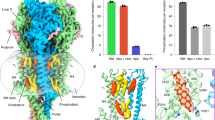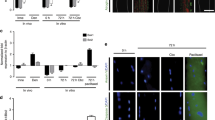Abstract
WHEN depolarising drugs are applied to the endplate region of skeletal muscle fibres, the postjunctional membrane undergoes a rapid increase in ionic conductance. This increased permeability, largely for Na+ and K+, is slowly reversed if the agonist application is sustained. The gradual diminuition of response to agonist is due to endplate desensitisation1. Many factors influencing desensitisation have been described, but the molecular mechanisms responsible for the development of desensitisation remain unknown. Two fundamental types of mechanisms have been postulated to explain the phenomenon of desensitisation2–6. In the first, desensitisation is viewed as resulting from an alteration in the chemical receptor or binding site. The second type of mechanism suggests that desensitisation results from an alteration at some extrareceptor site such as that controlling the ionic channel in the endplate membrane. Kuba and Koketsu7 have shown that the reversal potential for acetylcholine was shifted to more negative values at desensitised end-plates. They argued that this change was due to a selective decrease in GNa and therefore supported the view that an extra-receptor mechanism was important in the development of desensitisation. In contrast Koester8 found no significant alteration in the reversal potential at desensitised endplates. In view of these conflicting observations we have re-investigated the question of whether there is or is not a selective alteration in endplate conductance during desensitisation. We report here that desensitisation does not selectively alter sodium channels.
This is a preview of subscription content, access via your institution
Access options
Subscribe to this journal
Receive 51 print issues and online access
$199.00 per year
only $3.90 per issue
Buy this article
- Purchase on Springer Link
- Instant access to full article PDF
Prices may be subject to local taxes which are calculated during checkout
Similar content being viewed by others
References
Thesleff, S. Acta physiol. scand. 34, 218–231 (1955).
Katz, B. & Thesleff, S. J. Physiol., Lond. 138, 63–80 (1957).
Rang, H. P. & Ritter, J. M. Molec. Pharmac. 6, 357–382 (1970).
Magazanik, L. G. & Vyskocil, F. J. Physiol., Lond. 210, 507–518 (1970).
Magazanik, L. G. & Vyskocil, F. J. Physiol., Lond. 249, 285–300 (1975).
Nastuk, W. L. & Parsons, R. L. J. gen. Physiol. 56, 218–249 (1970).
Kuba, K. & Koketsu, K. Nature 262, 504–505 (1976).
Koester, J. D. thesis, Columbia Univ., New York (1971).
Lambert, D. H. & Parsons, R. L. J. gen. Physiol. 56, 309–321 (1970).
Manthey, A. A. J. gen. Physiol. 49, 963–976 (1966).
Takeuchi, A. & Takeuchi, N. J. Neurophysiol. 22, 395–411 (1959).
Gibbons, W. R. & Fozzard, H. A. Circ. Res. 28, 446–460 (1971).
Dionne, V. E. & Ruff, L. Nature 266, 263–265 (1977).
Dionne, V. E. & Stevens, C. F. J. Physiol., Lond. 251, 245–270 (1975).
Manalis, R. S. & Werman, R. in Electrobiology of Nerve, Synapse and Muscle (eds Reuben, J. P., Purpura, D. P., Bennett, M. V. L. & Kandel, E. R.) 50–51 (Raven, New York, 1976).
Author information
Authors and Affiliations
Rights and permissions
About this article
Cite this article
LAMBERT, D., SPANNBAUER, P. & PARSONS, R. Desensitisation does not selectively alter sodium channels. Nature 268, 553–555 (1977). https://doi.org/10.1038/268553a0
Received:
Accepted:
Issue Date:
DOI: https://doi.org/10.1038/268553a0
This article is cited by
-
Desensitization in denervated mouse muscles
Pflügers Archiv - European Journal of Physiology (1981)
-
Acetylcholine receptor kinetics
The Journal of Membrane Biology (1981)
Comments
By submitting a comment you agree to abide by our Terms and Community Guidelines. If you find something abusive or that does not comply with our terms or guidelines please flag it as inappropriate.



